MBA641 Strategic Project Management: Feasibility of Duplex Project
VerifiedAdded on 2023/06/07
|12
|2930
|92
Case Study
AI Summary
This case study presents a feasibility study and timeline review for a residential duplex development project in Wagga Wagga, focusing on a real estate development business with an $800,000 budget. The study assesses the economic viability of the project, considering factors like land information, purchase information, local council information, and construction costs. It also examines constraints such as budget, schedule, and scope, alongside goals related to project feasibility and timeline. The analysis identifies macro environment business drivers (economic, demographic, competitive) and micro environment business drivers (technical expertise, suppliers, market intermediaries, customer considerations, and time pressure) that influence the project's success. The study concludes that the project's timeline and feasibility analysis are critical for its initiation and success.
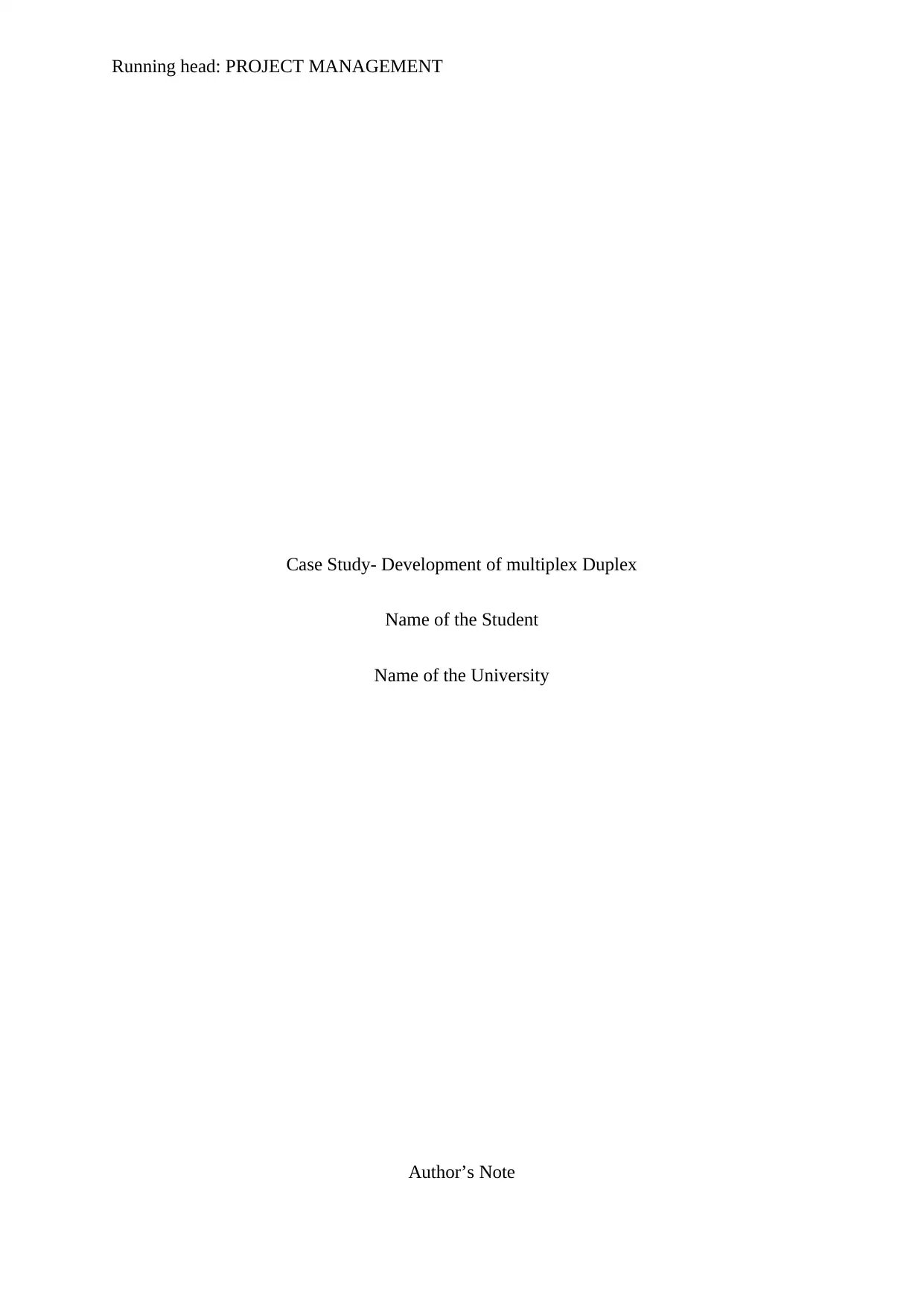
Running head: PROJECT MANAGEMENT
Case Study- Development of multiplex Duplex
Name of the Student
Name of the University
Author’s Note
Case Study- Development of multiplex Duplex
Name of the Student
Name of the University
Author’s Note
Paraphrase This Document
Need a fresh take? Get an instant paraphrase of this document with our AI Paraphraser
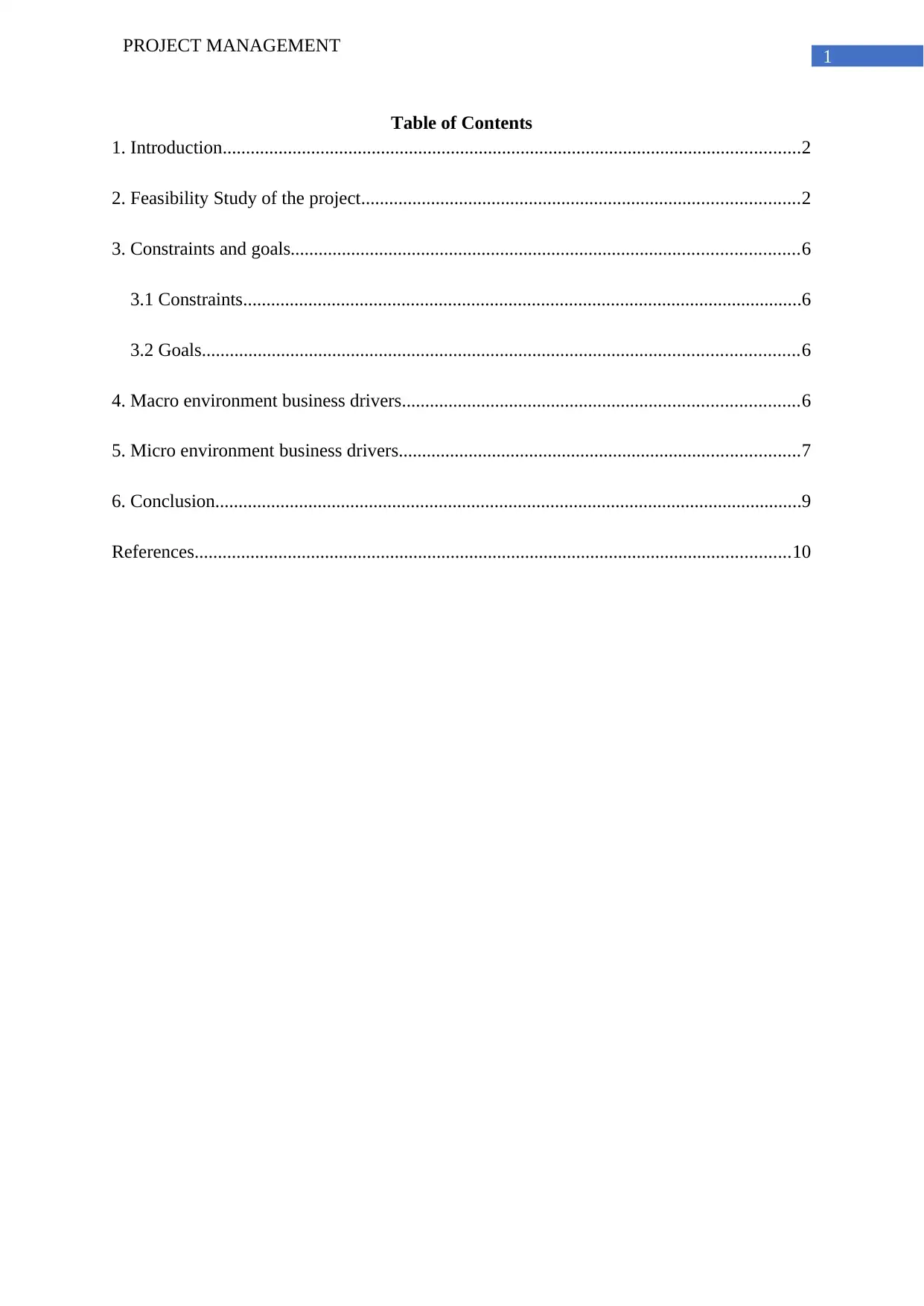
1
PROJECT MANAGEMENT
Table of Contents
1. Introduction............................................................................................................................2
2. Feasibility Study of the project..............................................................................................2
3. Constraints and goals.............................................................................................................6
3.1 Constraints........................................................................................................................6
3.2 Goals................................................................................................................................6
4. Macro environment business drivers.....................................................................................6
5. Micro environment business drivers......................................................................................7
6. Conclusion..............................................................................................................................9
References................................................................................................................................10
PROJECT MANAGEMENT
Table of Contents
1. Introduction............................................................................................................................2
2. Feasibility Study of the project..............................................................................................2
3. Constraints and goals.............................................................................................................6
3.1 Constraints........................................................................................................................6
3.2 Goals................................................................................................................................6
4. Macro environment business drivers.....................................................................................6
5. Micro environment business drivers......................................................................................7
6. Conclusion..............................................................................................................................9
References................................................................................................................................10
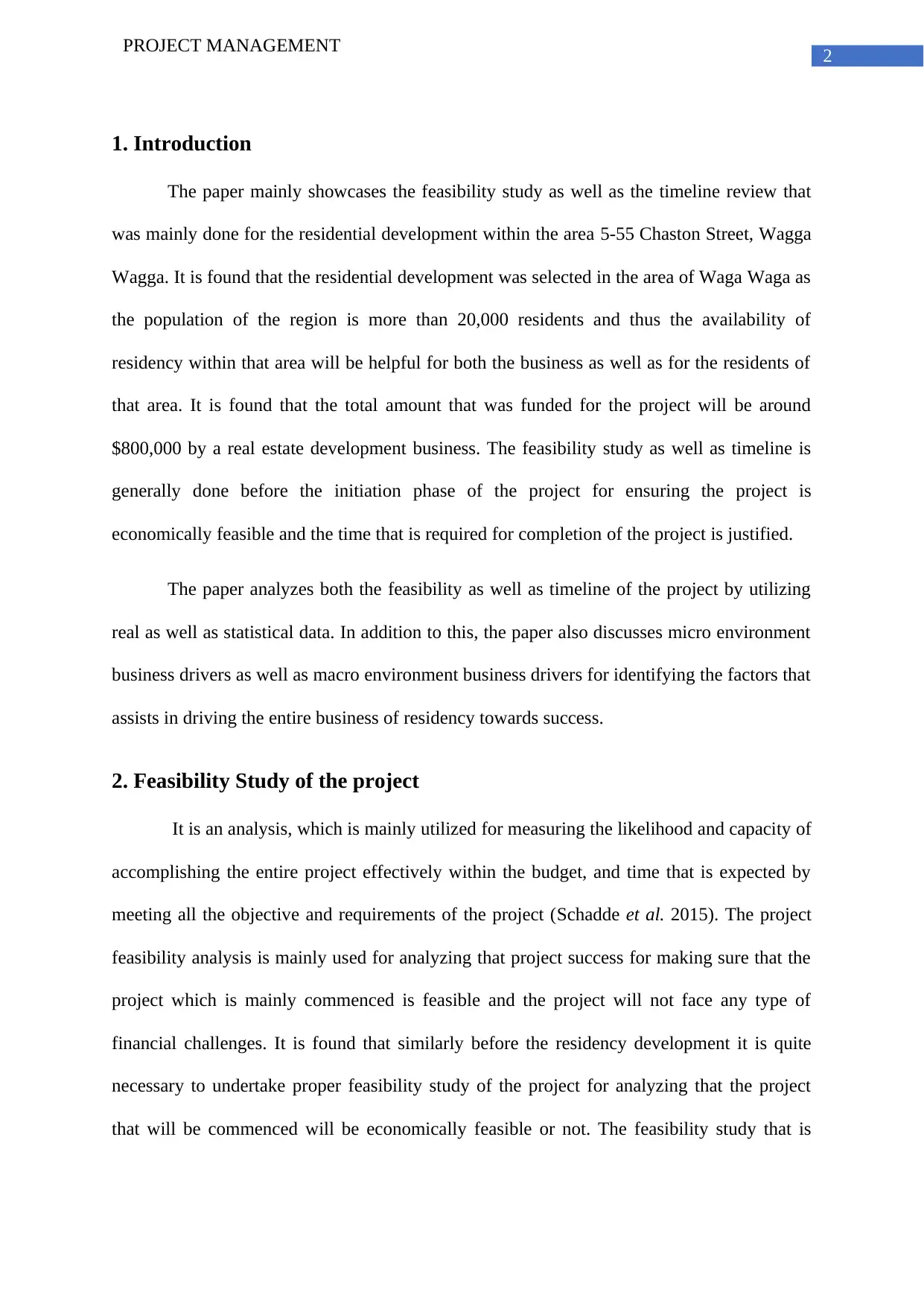
2
PROJECT MANAGEMENT
1. Introduction
The paper mainly showcases the feasibility study as well as the timeline review that
was mainly done for the residential development within the area 5-55 Chaston Street, Wagga
Wagga. It is found that the residential development was selected in the area of Waga Waga as
the population of the region is more than 20,000 residents and thus the availability of
residency within that area will be helpful for both the business as well as for the residents of
that area. It is found that the total amount that was funded for the project will be around
$800,000 by a real estate development business. The feasibility study as well as timeline is
generally done before the initiation phase of the project for ensuring the project is
economically feasible and the time that is required for completion of the project is justified.
The paper analyzes both the feasibility as well as timeline of the project by utilizing
real as well as statistical data. In addition to this, the paper also discusses micro environment
business drivers as well as macro environment business drivers for identifying the factors that
assists in driving the entire business of residency towards success.
2. Feasibility Study of the project
It is an analysis, which is mainly utilized for measuring the likelihood and capacity of
accomplishing the entire project effectively within the budget, and time that is expected by
meeting all the objective and requirements of the project (Schadde et al. 2015). The project
feasibility analysis is mainly used for analyzing that project success for making sure that the
project which is mainly commenced is feasible and the project will not face any type of
financial challenges. It is found that similarly before the residency development it is quite
necessary to undertake proper feasibility study of the project for analyzing that the project
that will be commenced will be economically feasible or not. The feasibility study that is
PROJECT MANAGEMENT
1. Introduction
The paper mainly showcases the feasibility study as well as the timeline review that
was mainly done for the residential development within the area 5-55 Chaston Street, Wagga
Wagga. It is found that the residential development was selected in the area of Waga Waga as
the population of the region is more than 20,000 residents and thus the availability of
residency within that area will be helpful for both the business as well as for the residents of
that area. It is found that the total amount that was funded for the project will be around
$800,000 by a real estate development business. The feasibility study as well as timeline is
generally done before the initiation phase of the project for ensuring the project is
economically feasible and the time that is required for completion of the project is justified.
The paper analyzes both the feasibility as well as timeline of the project by utilizing
real as well as statistical data. In addition to this, the paper also discusses micro environment
business drivers as well as macro environment business drivers for identifying the factors that
assists in driving the entire business of residency towards success.
2. Feasibility Study of the project
It is an analysis, which is mainly utilized for measuring the likelihood and capacity of
accomplishing the entire project effectively within the budget, and time that is expected by
meeting all the objective and requirements of the project (Schadde et al. 2015). The project
feasibility analysis is mainly used for analyzing that project success for making sure that the
project which is mainly commenced is feasible and the project will not face any type of
financial challenges. It is found that similarly before the residency development it is quite
necessary to undertake proper feasibility study of the project for analyzing that the project
that will be commenced will be economically feasible or not. The feasibility study that is
⊘ This is a preview!⊘
Do you want full access?
Subscribe today to unlock all pages.

Trusted by 1+ million students worldwide
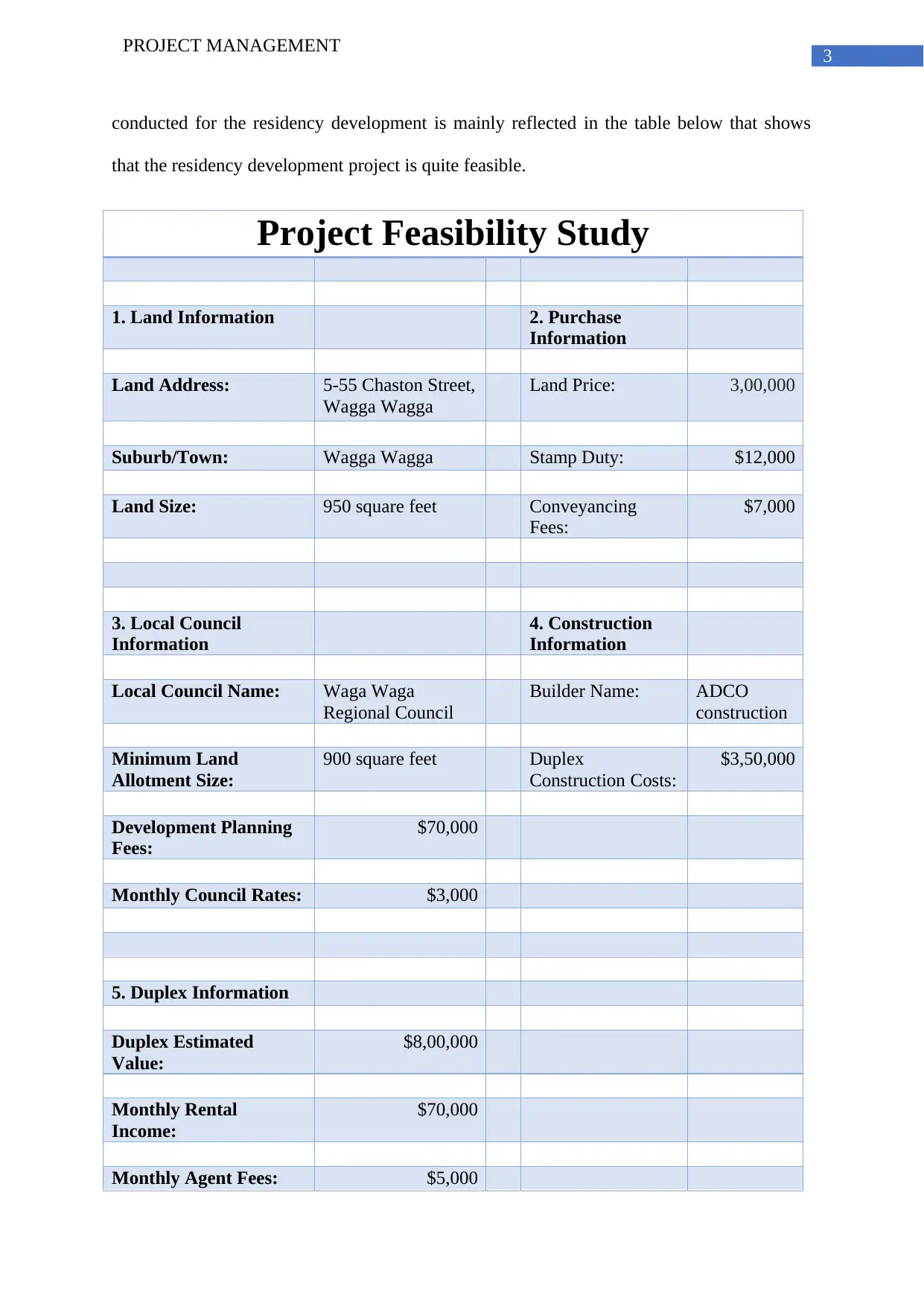
3
PROJECT MANAGEMENT
conducted for the residency development is mainly reflected in the table below that shows
that the residency development project is quite feasible.
Project Feasibility Study
1. Land Information 2. Purchase
Information
Land Address: 5-55 Chaston Street,
Wagga Wagga
Land Price: 3,00,000
Suburb/Town: Wagga Wagga Stamp Duty: $12,000
Land Size: 950 square feet Conveyancing
Fees:
$7,000
3. Local Council
Information
4. Construction
Information
Local Council Name: Waga Waga
Regional Council
Builder Name: ADCO
construction
Minimum Land
Allotment Size:
900 square feet Duplex
Construction Costs:
$3,50,000
Development Planning
Fees:
$70,000
Monthly Council Rates: $3,000
5. Duplex Information
Duplex Estimated
Value:
$8,00,000
Monthly Rental
Income:
$70,000
Monthly Agent Fees: $5,000
PROJECT MANAGEMENT
conducted for the residency development is mainly reflected in the table below that shows
that the residency development project is quite feasible.
Project Feasibility Study
1. Land Information 2. Purchase
Information
Land Address: 5-55 Chaston Street,
Wagga Wagga
Land Price: 3,00,000
Suburb/Town: Wagga Wagga Stamp Duty: $12,000
Land Size: 950 square feet Conveyancing
Fees:
$7,000
3. Local Council
Information
4. Construction
Information
Local Council Name: Waga Waga
Regional Council
Builder Name: ADCO
construction
Minimum Land
Allotment Size:
900 square feet Duplex
Construction Costs:
$3,50,000
Development Planning
Fees:
$70,000
Monthly Council Rates: $3,000
5. Duplex Information
Duplex Estimated
Value:
$8,00,000
Monthly Rental
Income:
$70,000
Monthly Agent Fees: $5,000
Paraphrase This Document
Need a fresh take? Get an instant paraphrase of this document with our AI Paraphraser
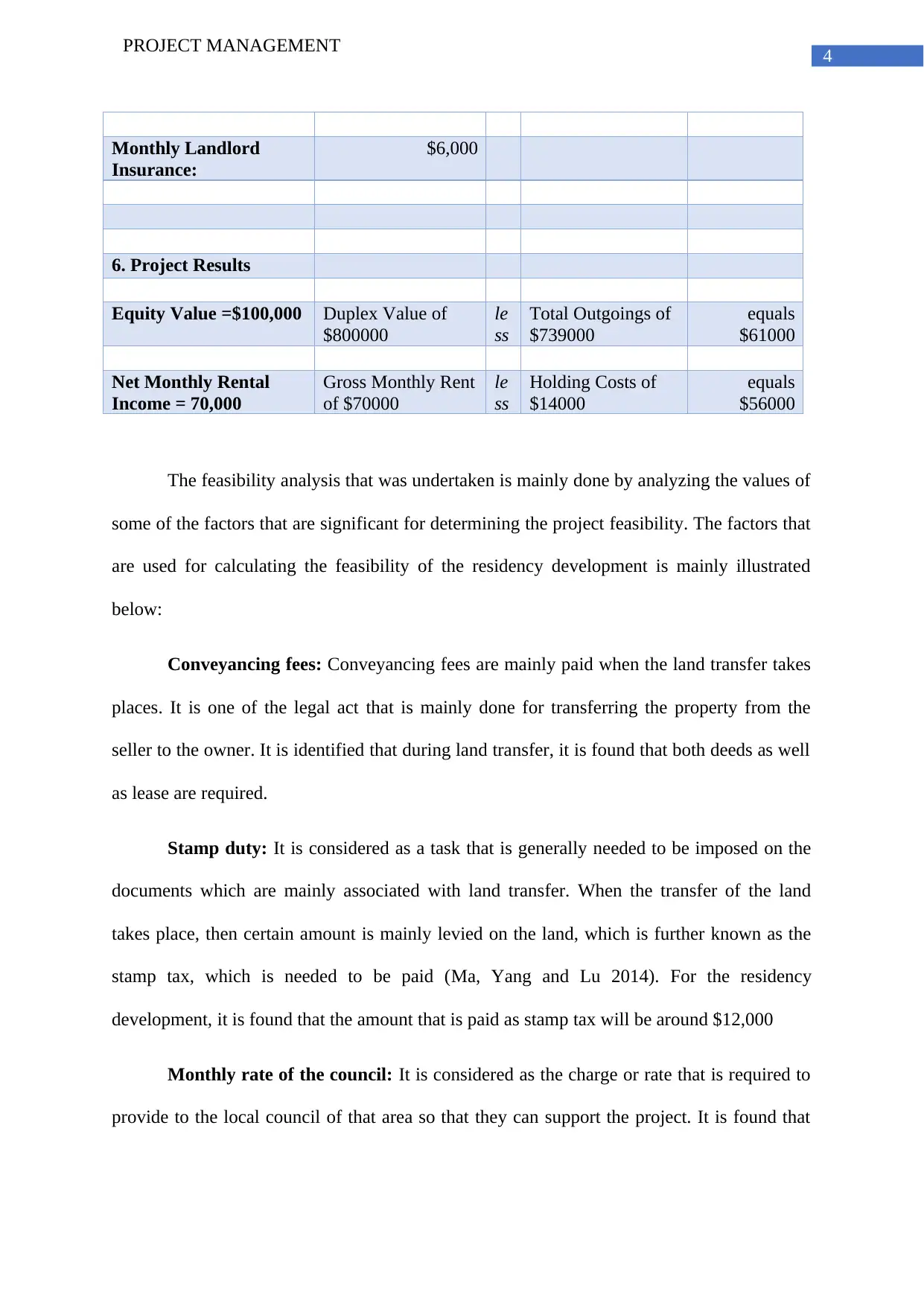
4
PROJECT MANAGEMENT
Monthly Landlord
Insurance:
$6,000
6. Project Results
Equity Value =$100,000 Duplex Value of
$800000
le
ss
Total Outgoings of
$739000
equals
$61000
Net Monthly Rental
Income = 70,000
Gross Monthly Rent
of $70000
le
ss
Holding Costs of
$14000
equals
$56000
The feasibility analysis that was undertaken is mainly done by analyzing the values of
some of the factors that are significant for determining the project feasibility. The factors that
are used for calculating the feasibility of the residency development is mainly illustrated
below:
Conveyancing fees: Conveyancing fees are mainly paid when the land transfer takes
places. It is one of the legal act that is mainly done for transferring the property from the
seller to the owner. It is identified that during land transfer, it is found that both deeds as well
as lease are required.
Stamp duty: It is considered as a task that is generally needed to be imposed on the
documents which are mainly associated with land transfer. When the transfer of the land
takes place, then certain amount is mainly levied on the land, which is further known as the
stamp tax, which is needed to be paid (Ma, Yang and Lu 2014). For the residency
development, it is found that the amount that is paid as stamp tax will be around $12,000
Monthly rate of the council: It is considered as the charge or rate that is required to
provide to the local council of that area so that they can support the project. It is found that
PROJECT MANAGEMENT
Monthly Landlord
Insurance:
$6,000
6. Project Results
Equity Value =$100,000 Duplex Value of
$800000
le
ss
Total Outgoings of
$739000
equals
$61000
Net Monthly Rental
Income = 70,000
Gross Monthly Rent
of $70000
le
ss
Holding Costs of
$14000
equals
$56000
The feasibility analysis that was undertaken is mainly done by analyzing the values of
some of the factors that are significant for determining the project feasibility. The factors that
are used for calculating the feasibility of the residency development is mainly illustrated
below:
Conveyancing fees: Conveyancing fees are mainly paid when the land transfer takes
places. It is one of the legal act that is mainly done for transferring the property from the
seller to the owner. It is identified that during land transfer, it is found that both deeds as well
as lease are required.
Stamp duty: It is considered as a task that is generally needed to be imposed on the
documents which are mainly associated with land transfer. When the transfer of the land
takes place, then certain amount is mainly levied on the land, which is further known as the
stamp tax, which is needed to be paid (Ma, Yang and Lu 2014). For the residency
development, it is found that the amount that is paid as stamp tax will be around $12,000
Monthly rate of the council: It is considered as the charge or rate that is required to
provide to the local council of that area so that they can support the project. It is found that
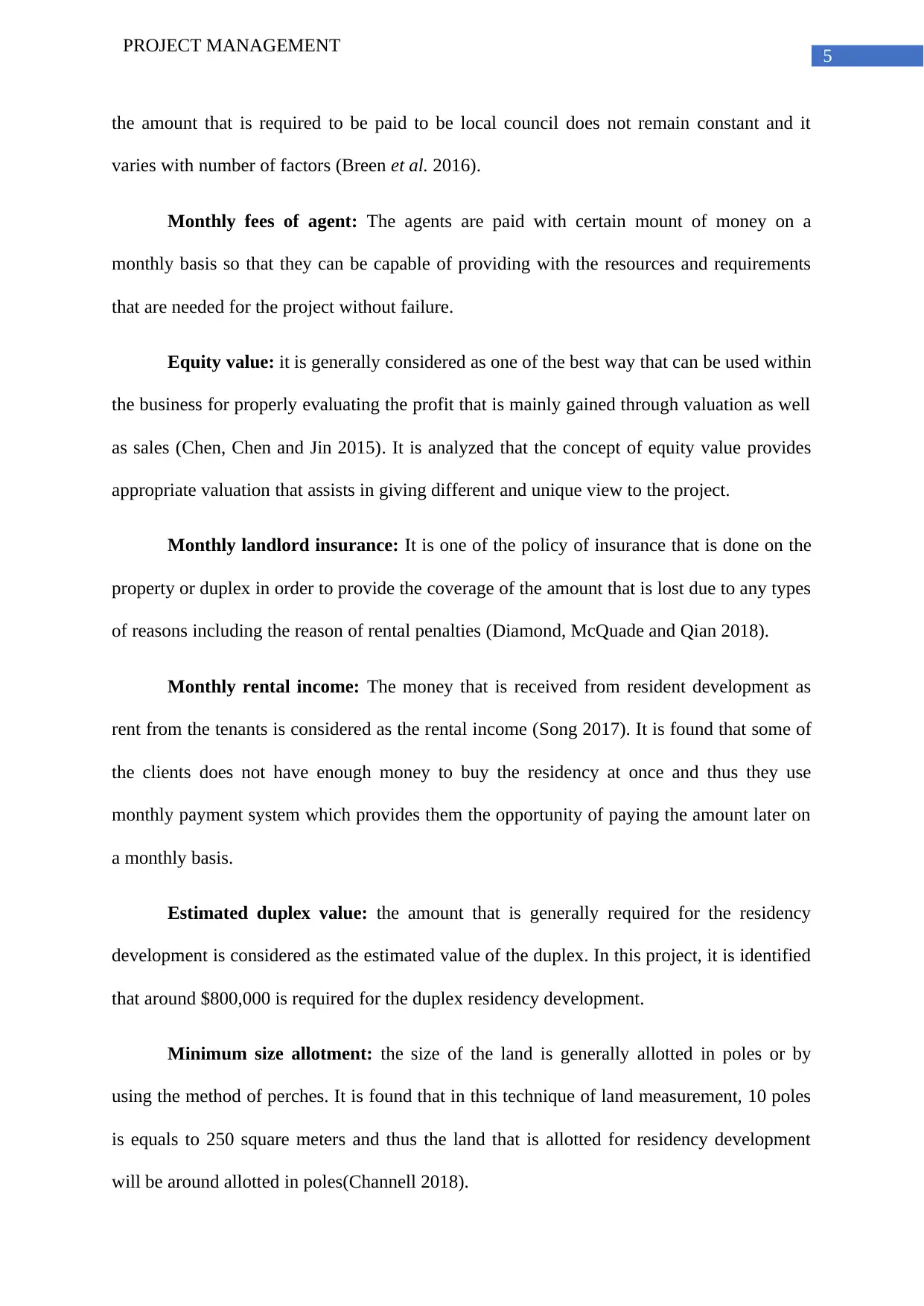
5
PROJECT MANAGEMENT
the amount that is required to be paid to be local council does not remain constant and it
varies with number of factors (Breen et al. 2016).
Monthly fees of agent: The agents are paid with certain mount of money on a
monthly basis so that they can be capable of providing with the resources and requirements
that are needed for the project without failure.
Equity value: it is generally considered as one of the best way that can be used within
the business for properly evaluating the profit that is mainly gained through valuation as well
as sales (Chen, Chen and Jin 2015). It is analyzed that the concept of equity value provides
appropriate valuation that assists in giving different and unique view to the project.
Monthly landlord insurance: It is one of the policy of insurance that is done on the
property or duplex in order to provide the coverage of the amount that is lost due to any types
of reasons including the reason of rental penalties (Diamond, McQuade and Qian 2018).
Monthly rental income: The money that is received from resident development as
rent from the tenants is considered as the rental income (Song 2017). It is found that some of
the clients does not have enough money to buy the residency at once and thus they use
monthly payment system which provides them the opportunity of paying the amount later on
a monthly basis.
Estimated duplex value: the amount that is generally required for the residency
development is considered as the estimated value of the duplex. In this project, it is identified
that around $800,000 is required for the duplex residency development.
Minimum size allotment: the size of the land is generally allotted in poles or by
using the method of perches. It is found that in this technique of land measurement, 10 poles
is equals to 250 square meters and thus the land that is allotted for residency development
will be around allotted in poles(Channell 2018).
PROJECT MANAGEMENT
the amount that is required to be paid to be local council does not remain constant and it
varies with number of factors (Breen et al. 2016).
Monthly fees of agent: The agents are paid with certain mount of money on a
monthly basis so that they can be capable of providing with the resources and requirements
that are needed for the project without failure.
Equity value: it is generally considered as one of the best way that can be used within
the business for properly evaluating the profit that is mainly gained through valuation as well
as sales (Chen, Chen and Jin 2015). It is analyzed that the concept of equity value provides
appropriate valuation that assists in giving different and unique view to the project.
Monthly landlord insurance: It is one of the policy of insurance that is done on the
property or duplex in order to provide the coverage of the amount that is lost due to any types
of reasons including the reason of rental penalties (Diamond, McQuade and Qian 2018).
Monthly rental income: The money that is received from resident development as
rent from the tenants is considered as the rental income (Song 2017). It is found that some of
the clients does not have enough money to buy the residency at once and thus they use
monthly payment system which provides them the opportunity of paying the amount later on
a monthly basis.
Estimated duplex value: the amount that is generally required for the residency
development is considered as the estimated value of the duplex. In this project, it is identified
that around $800,000 is required for the duplex residency development.
Minimum size allotment: the size of the land is generally allotted in poles or by
using the method of perches. It is found that in this technique of land measurement, 10 poles
is equals to 250 square meters and thus the land that is allotted for residency development
will be around allotted in poles(Channell 2018).
⊘ This is a preview!⊘
Do you want full access?
Subscribe today to unlock all pages.

Trusted by 1+ million students worldwide
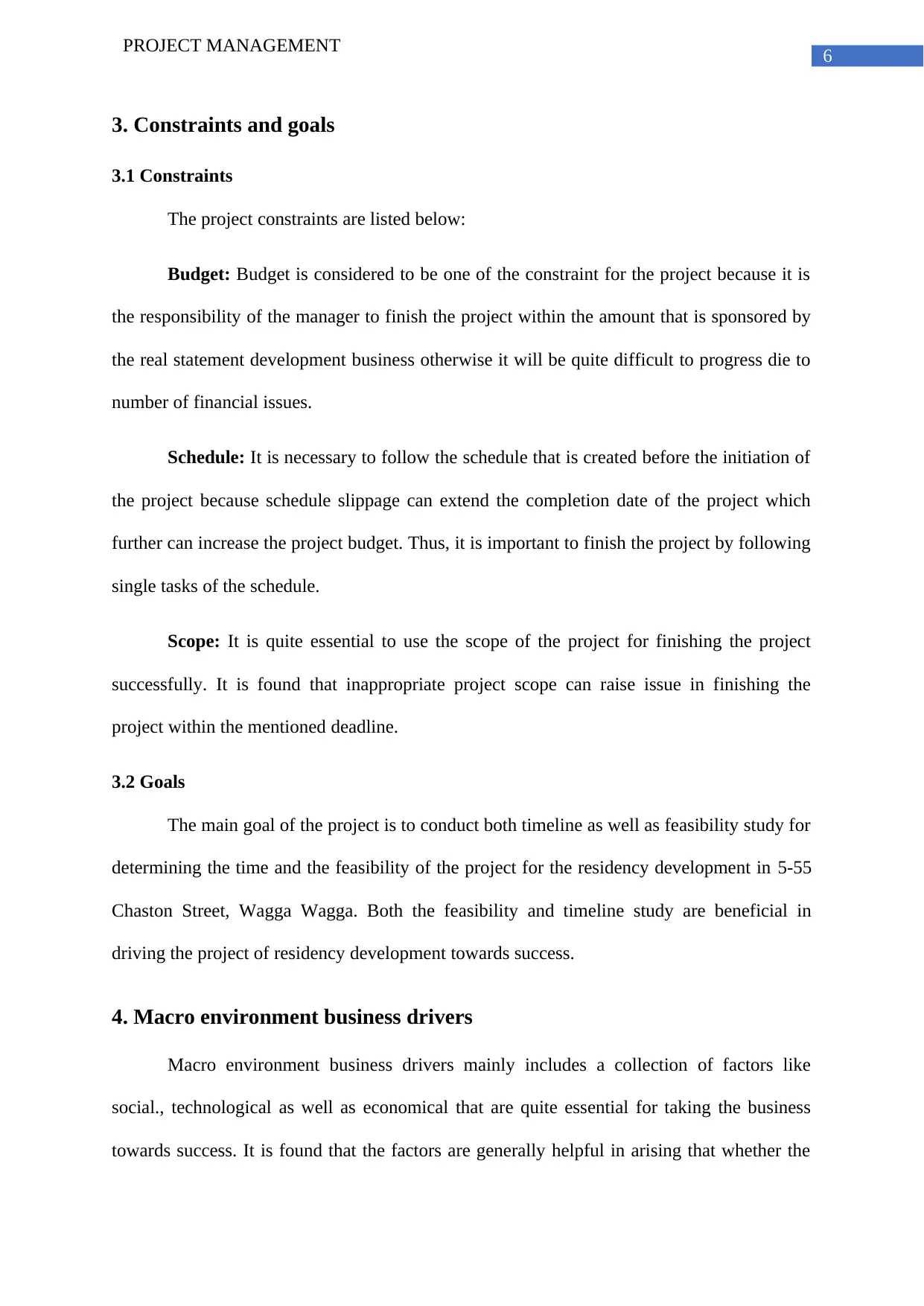
6
PROJECT MANAGEMENT
3. Constraints and goals
3.1 Constraints
The project constraints are listed below:
Budget: Budget is considered to be one of the constraint for the project because it is
the responsibility of the manager to finish the project within the amount that is sponsored by
the real statement development business otherwise it will be quite difficult to progress die to
number of financial issues.
Schedule: It is necessary to follow the schedule that is created before the initiation of
the project because schedule slippage can extend the completion date of the project which
further can increase the project budget. Thus, it is important to finish the project by following
single tasks of the schedule.
Scope: It is quite essential to use the scope of the project for finishing the project
successfully. It is found that inappropriate project scope can raise issue in finishing the
project within the mentioned deadline.
3.2 Goals
The main goal of the project is to conduct both timeline as well as feasibility study for
determining the time and the feasibility of the project for the residency development in 5-55
Chaston Street, Wagga Wagga. Both the feasibility and timeline study are beneficial in
driving the project of residency development towards success.
4. Macro environment business drivers
Macro environment business drivers mainly includes a collection of factors like
social., technological as well as economical that are quite essential for taking the business
towards success. It is found that the factors are generally helpful in arising that whether the
PROJECT MANAGEMENT
3. Constraints and goals
3.1 Constraints
The project constraints are listed below:
Budget: Budget is considered to be one of the constraint for the project because it is
the responsibility of the manager to finish the project within the amount that is sponsored by
the real statement development business otherwise it will be quite difficult to progress die to
number of financial issues.
Schedule: It is necessary to follow the schedule that is created before the initiation of
the project because schedule slippage can extend the completion date of the project which
further can increase the project budget. Thus, it is important to finish the project by following
single tasks of the schedule.
Scope: It is quite essential to use the scope of the project for finishing the project
successfully. It is found that inappropriate project scope can raise issue in finishing the
project within the mentioned deadline.
3.2 Goals
The main goal of the project is to conduct both timeline as well as feasibility study for
determining the time and the feasibility of the project for the residency development in 5-55
Chaston Street, Wagga Wagga. Both the feasibility and timeline study are beneficial in
driving the project of residency development towards success.
4. Macro environment business drivers
Macro environment business drivers mainly includes a collection of factors like
social., technological as well as economical that are quite essential for taking the business
towards success. It is found that the factors are generally helpful in arising that whether the
Paraphrase This Document
Need a fresh take? Get an instant paraphrase of this document with our AI Paraphraser

7
PROJECT MANAGEMENT
factors are playing important role in driving the business or not (Ngo et al. 2016). In the
project of residential development, it is analyzed that there are number of macro environment
related factors that are found to be beneficial in driving the business towards achievement of
success. The factors are illustrated below:
Economic: Economy is one of the macro environment factor that plays a great role in
the business and it generally assists in creating impact on both the purchase as well as
spending. It is found that in residency development project, the money that will be received
as income is from the rent (Gurhan-Canli, Hayran and Sarial-Abi 2016). It is found that the
money that is gained as income needs to be compared with the investment that is made for
making sure that the residency development project as driven economically.
Demographic: It is considered as one of the macro environment factors that are
mainly related with the people and it analyzed that the region of Waga Waga is populated and
thus this factor will be helpful in driving the business positively (Todeschini et al. 2017). It is
analyzed that this particular factors gives number of opportunities to the business for
flourishing.
Competitive: It is analyzed that the population of the Waga Waga region is not much
low and thus the chances of presence of other competitors are high. Thus the business needs
to provide quite opportunities as well as services for attracting the clients towards business so
that the business can achieve success.
5. Micro environment business drivers
The microenvironment mainly includes the factors that mainly help in affecting the
process, performance of the entire business. It is found that the analysis is generally
conducted for making sure that which factor is helpful in driving the business towards
success. The factors include:
PROJECT MANAGEMENT
factors are playing important role in driving the business or not (Ngo et al. 2016). In the
project of residential development, it is analyzed that there are number of macro environment
related factors that are found to be beneficial in driving the business towards achievement of
success. The factors are illustrated below:
Economic: Economy is one of the macro environment factor that plays a great role in
the business and it generally assists in creating impact on both the purchase as well as
spending. It is found that in residency development project, the money that will be received
as income is from the rent (Gurhan-Canli, Hayran and Sarial-Abi 2016). It is found that the
money that is gained as income needs to be compared with the investment that is made for
making sure that the residency development project as driven economically.
Demographic: It is considered as one of the macro environment factors that are
mainly related with the people and it analyzed that the region of Waga Waga is populated and
thus this factor will be helpful in driving the business positively (Todeschini et al. 2017). It is
analyzed that this particular factors gives number of opportunities to the business for
flourishing.
Competitive: It is analyzed that the population of the Waga Waga region is not much
low and thus the chances of presence of other competitors are high. Thus the business needs
to provide quite opportunities as well as services for attracting the clients towards business so
that the business can achieve success.
5. Micro environment business drivers
The microenvironment mainly includes the factors that mainly help in affecting the
process, performance of the entire business. It is found that the analysis is generally
conducted for making sure that which factor is helpful in driving the business towards
success. The factors include:
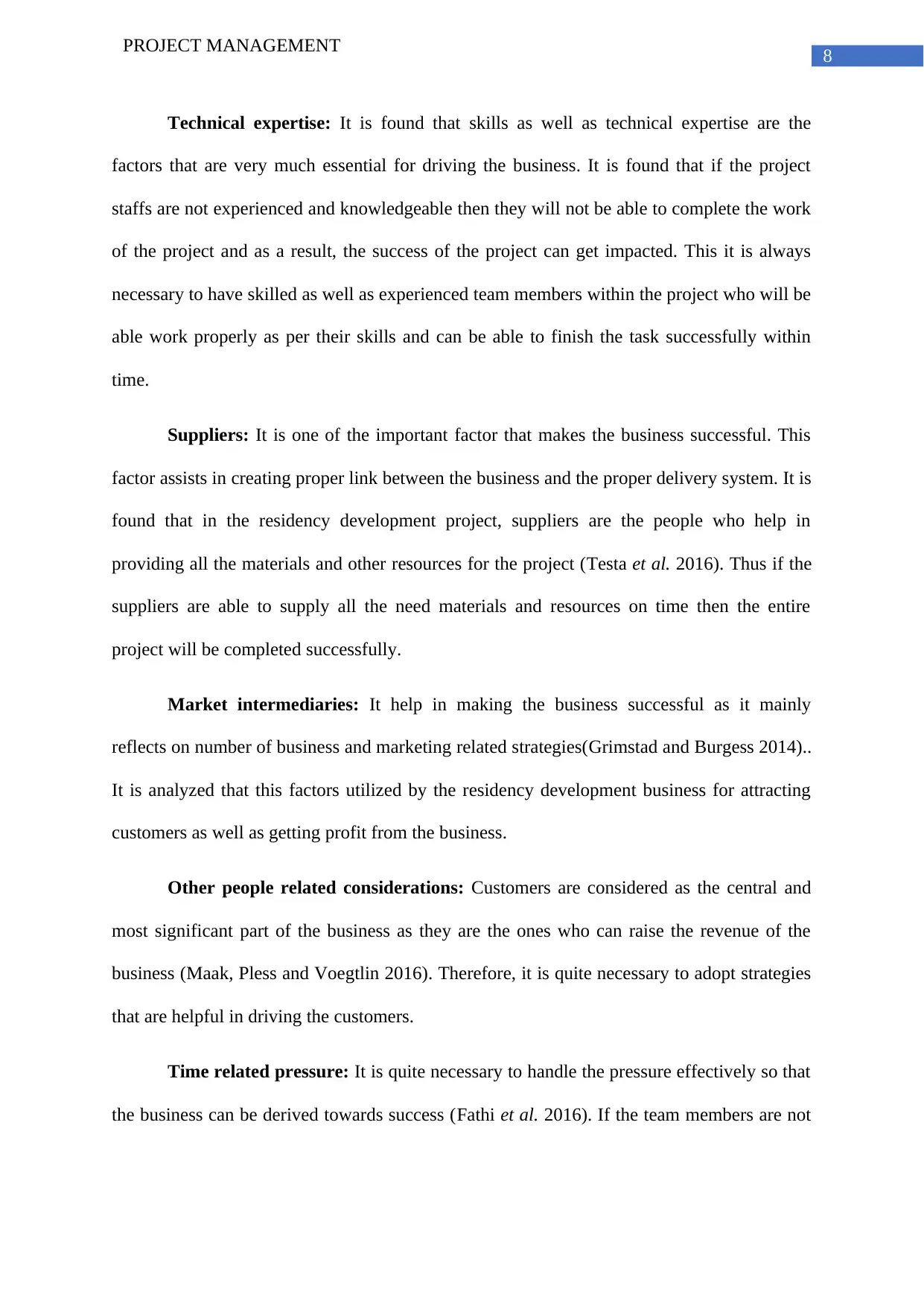
8
PROJECT MANAGEMENT
Technical expertise: It is found that skills as well as technical expertise are the
factors that are very much essential for driving the business. It is found that if the project
staffs are not experienced and knowledgeable then they will not be able to complete the work
of the project and as a result, the success of the project can get impacted. This it is always
necessary to have skilled as well as experienced team members within the project who will be
able work properly as per their skills and can be able to finish the task successfully within
time.
Suppliers: It is one of the important factor that makes the business successful. This
factor assists in creating proper link between the business and the proper delivery system. It is
found that in the residency development project, suppliers are the people who help in
providing all the materials and other resources for the project (Testa et al. 2016). Thus if the
suppliers are able to supply all the need materials and resources on time then the entire
project will be completed successfully.
Market intermediaries: It help in making the business successful as it mainly
reflects on number of business and marketing related strategies(Grimstad and Burgess 2014)..
It is analyzed that this factors utilized by the residency development business for attracting
customers as well as getting profit from the business.
Other people related considerations: Customers are considered as the central and
most significant part of the business as they are the ones who can raise the revenue of the
business (Maak, Pless and Voegtlin 2016). Therefore, it is quite necessary to adopt strategies
that are helpful in driving the customers.
Time related pressure: It is quite necessary to handle the pressure effectively so that
the business can be derived towards success (Fathi et al. 2016). If the team members are not
PROJECT MANAGEMENT
Technical expertise: It is found that skills as well as technical expertise are the
factors that are very much essential for driving the business. It is found that if the project
staffs are not experienced and knowledgeable then they will not be able to complete the work
of the project and as a result, the success of the project can get impacted. This it is always
necessary to have skilled as well as experienced team members within the project who will be
able work properly as per their skills and can be able to finish the task successfully within
time.
Suppliers: It is one of the important factor that makes the business successful. This
factor assists in creating proper link between the business and the proper delivery system. It is
found that in the residency development project, suppliers are the people who help in
providing all the materials and other resources for the project (Testa et al. 2016). Thus if the
suppliers are able to supply all the need materials and resources on time then the entire
project will be completed successfully.
Market intermediaries: It help in making the business successful as it mainly
reflects on number of business and marketing related strategies(Grimstad and Burgess 2014)..
It is analyzed that this factors utilized by the residency development business for attracting
customers as well as getting profit from the business.
Other people related considerations: Customers are considered as the central and
most significant part of the business as they are the ones who can raise the revenue of the
business (Maak, Pless and Voegtlin 2016). Therefore, it is quite necessary to adopt strategies
that are helpful in driving the customers.
Time related pressure: It is quite necessary to handle the pressure effectively so that
the business can be derived towards success (Fathi et al. 2016). If the team members are not
⊘ This is a preview!⊘
Do you want full access?
Subscribe today to unlock all pages.

Trusted by 1+ million students worldwide
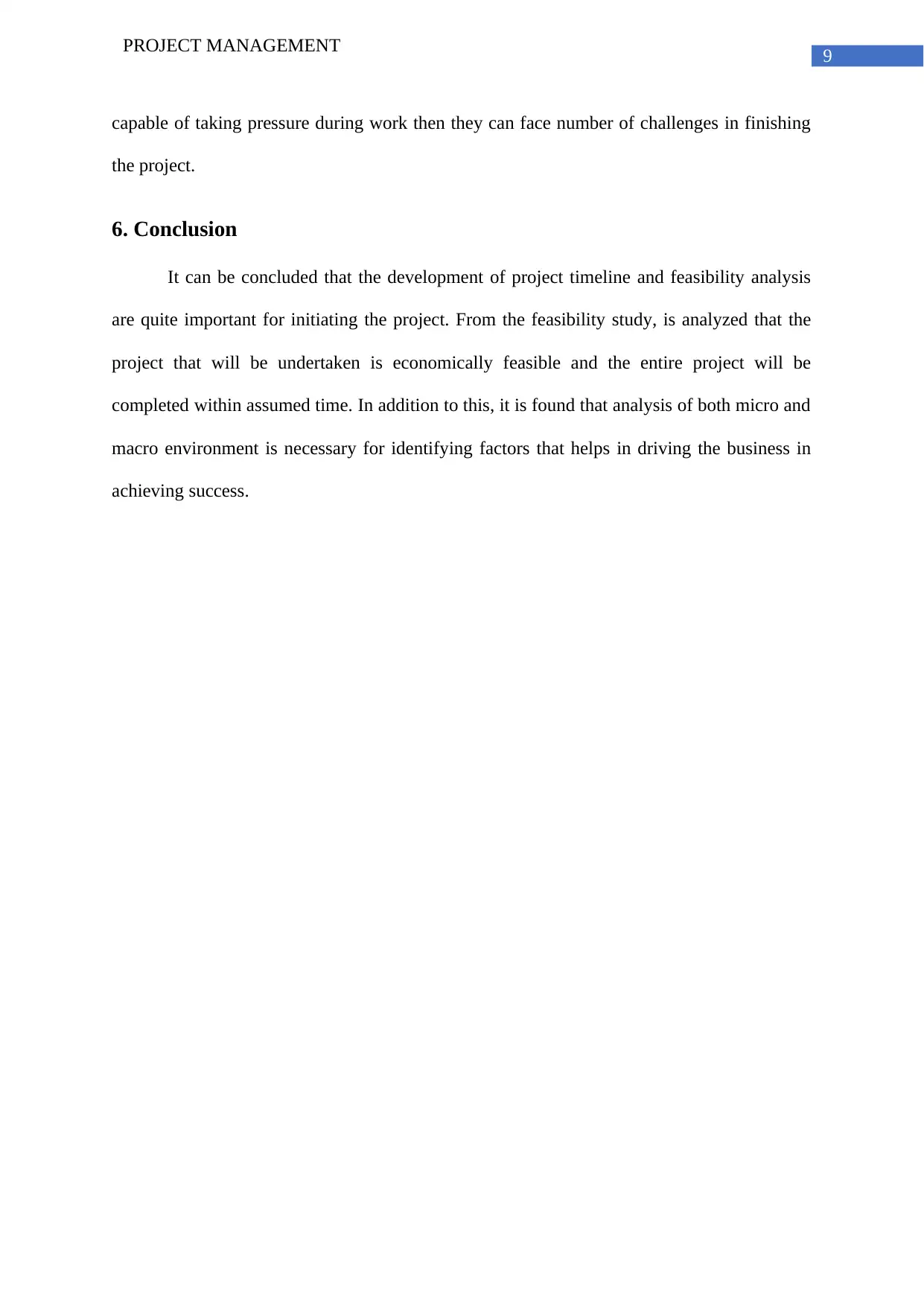
9
PROJECT MANAGEMENT
capable of taking pressure during work then they can face number of challenges in finishing
the project.
6. Conclusion
It can be concluded that the development of project timeline and feasibility analysis
are quite important for initiating the project. From the feasibility study, is analyzed that the
project that will be undertaken is economically feasible and the entire project will be
completed within assumed time. In addition to this, it is found that analysis of both micro and
macro environment is necessary for identifying factors that helps in driving the business in
achieving success.
PROJECT MANAGEMENT
capable of taking pressure during work then they can face number of challenges in finishing
the project.
6. Conclusion
It can be concluded that the development of project timeline and feasibility analysis
are quite important for initiating the project. From the feasibility study, is analyzed that the
project that will be undertaken is economically feasible and the entire project will be
completed within assumed time. In addition to this, it is found that analysis of both micro and
macro environment is necessary for identifying factors that helps in driving the business in
achieving success.
Paraphrase This Document
Need a fresh take? Get an instant paraphrase of this document with our AI Paraphraser
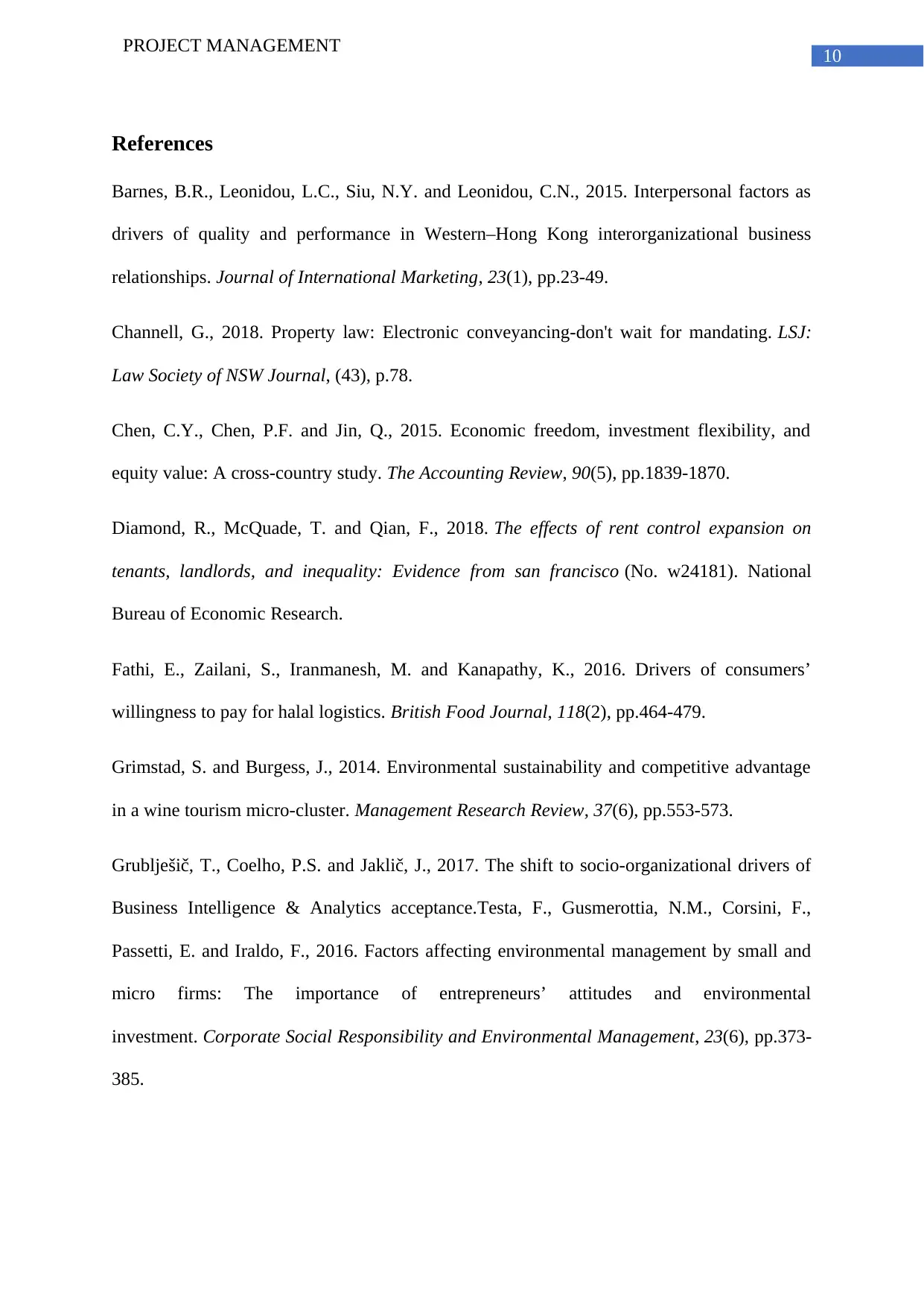
10
PROJECT MANAGEMENT
References
Barnes, B.R., Leonidou, L.C., Siu, N.Y. and Leonidou, C.N., 2015. Interpersonal factors as
drivers of quality and performance in Western–Hong Kong interorganizational business
relationships. Journal of International Marketing, 23(1), pp.23-49.
Channell, G., 2018. Property law: Electronic conveyancing-don't wait for mandating. LSJ:
Law Society of NSW Journal, (43), p.78.
Chen, C.Y., Chen, P.F. and Jin, Q., 2015. Economic freedom, investment flexibility, and
equity value: A cross-country study. The Accounting Review, 90(5), pp.1839-1870.
Diamond, R., McQuade, T. and Qian, F., 2018. The effects of rent control expansion on
tenants, landlords, and inequality: Evidence from san francisco (No. w24181). National
Bureau of Economic Research.
Fathi, E., Zailani, S., Iranmanesh, M. and Kanapathy, K., 2016. Drivers of consumers’
willingness to pay for halal logistics. British Food Journal, 118(2), pp.464-479.
Grimstad, S. and Burgess, J., 2014. Environmental sustainability and competitive advantage
in a wine tourism micro-cluster. Management Research Review, 37(6), pp.553-573.
Grublješič, T., Coelho, P.S. and Jaklič, J., 2017. The shift to socio-organizational drivers of
Business Intelligence & Analytics acceptance.Testa, F., Gusmerottia, N.M., Corsini, F.,
Passetti, E. and Iraldo, F., 2016. Factors affecting environmental management by small and
micro firms: The importance of entrepreneurs’ attitudes and environmental
investment. Corporate Social Responsibility and Environmental Management, 23(6), pp.373-
385.
PROJECT MANAGEMENT
References
Barnes, B.R., Leonidou, L.C., Siu, N.Y. and Leonidou, C.N., 2015. Interpersonal factors as
drivers of quality and performance in Western–Hong Kong interorganizational business
relationships. Journal of International Marketing, 23(1), pp.23-49.
Channell, G., 2018. Property law: Electronic conveyancing-don't wait for mandating. LSJ:
Law Society of NSW Journal, (43), p.78.
Chen, C.Y., Chen, P.F. and Jin, Q., 2015. Economic freedom, investment flexibility, and
equity value: A cross-country study. The Accounting Review, 90(5), pp.1839-1870.
Diamond, R., McQuade, T. and Qian, F., 2018. The effects of rent control expansion on
tenants, landlords, and inequality: Evidence from san francisco (No. w24181). National
Bureau of Economic Research.
Fathi, E., Zailani, S., Iranmanesh, M. and Kanapathy, K., 2016. Drivers of consumers’
willingness to pay for halal logistics. British Food Journal, 118(2), pp.464-479.
Grimstad, S. and Burgess, J., 2014. Environmental sustainability and competitive advantage
in a wine tourism micro-cluster. Management Research Review, 37(6), pp.553-573.
Grublješič, T., Coelho, P.S. and Jaklič, J., 2017. The shift to socio-organizational drivers of
Business Intelligence & Analytics acceptance.Testa, F., Gusmerottia, N.M., Corsini, F.,
Passetti, E. and Iraldo, F., 2016. Factors affecting environmental management by small and
micro firms: The importance of entrepreneurs’ attitudes and environmental
investment. Corporate Social Responsibility and Environmental Management, 23(6), pp.373-
385.
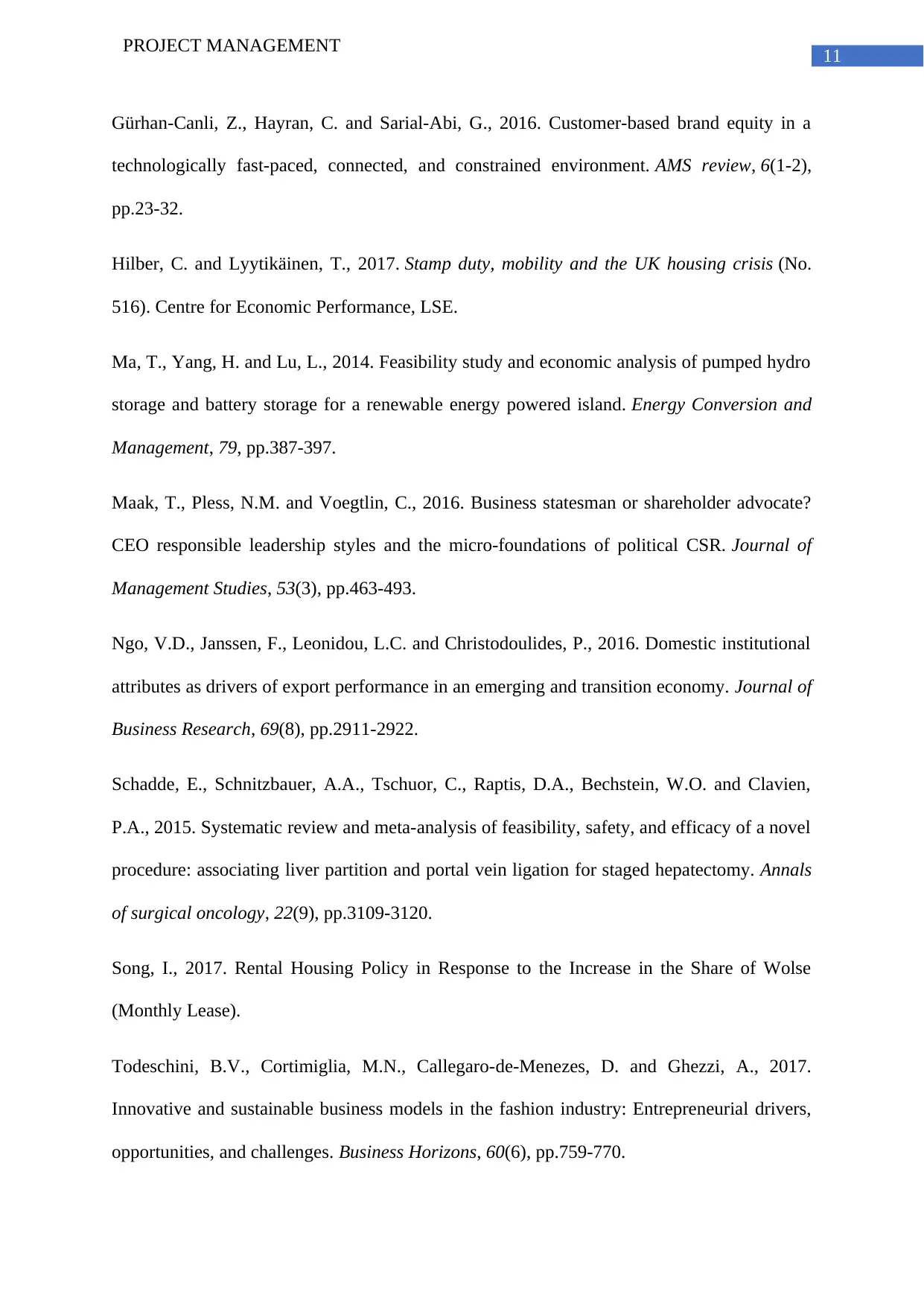
11
PROJECT MANAGEMENT
Gürhan-Canli, Z., Hayran, C. and Sarial-Abi, G., 2016. Customer-based brand equity in a
technologically fast-paced, connected, and constrained environment. AMS review, 6(1-2),
pp.23-32.
Hilber, C. and Lyytikäinen, T., 2017. Stamp duty, mobility and the UK housing crisis (No.
516). Centre for Economic Performance, LSE.
Ma, T., Yang, H. and Lu, L., 2014. Feasibility study and economic analysis of pumped hydro
storage and battery storage for a renewable energy powered island. Energy Conversion and
Management, 79, pp.387-397.
Maak, T., Pless, N.M. and Voegtlin, C., 2016. Business statesman or shareholder advocate?
CEO responsible leadership styles and the micro‐foundations of political CSR. Journal of
Management Studies, 53(3), pp.463-493.
Ngo, V.D., Janssen, F., Leonidou, L.C. and Christodoulides, P., 2016. Domestic institutional
attributes as drivers of export performance in an emerging and transition economy. Journal of
Business Research, 69(8), pp.2911-2922.
Schadde, E., Schnitzbauer, A.A., Tschuor, C., Raptis, D.A., Bechstein, W.O. and Clavien,
P.A., 2015. Systematic review and meta-analysis of feasibility, safety, and efficacy of a novel
procedure: associating liver partition and portal vein ligation for staged hepatectomy. Annals
of surgical oncology, 22(9), pp.3109-3120.
Song, I., 2017. Rental Housing Policy in Response to the Increase in the Share of Wolse
(Monthly Lease).
Todeschini, B.V., Cortimiglia, M.N., Callegaro-de-Menezes, D. and Ghezzi, A., 2017.
Innovative and sustainable business models in the fashion industry: Entrepreneurial drivers,
opportunities, and challenges. Business Horizons, 60(6), pp.759-770.
PROJECT MANAGEMENT
Gürhan-Canli, Z., Hayran, C. and Sarial-Abi, G., 2016. Customer-based brand equity in a
technologically fast-paced, connected, and constrained environment. AMS review, 6(1-2),
pp.23-32.
Hilber, C. and Lyytikäinen, T., 2017. Stamp duty, mobility and the UK housing crisis (No.
516). Centre for Economic Performance, LSE.
Ma, T., Yang, H. and Lu, L., 2014. Feasibility study and economic analysis of pumped hydro
storage and battery storage for a renewable energy powered island. Energy Conversion and
Management, 79, pp.387-397.
Maak, T., Pless, N.M. and Voegtlin, C., 2016. Business statesman or shareholder advocate?
CEO responsible leadership styles and the micro‐foundations of political CSR. Journal of
Management Studies, 53(3), pp.463-493.
Ngo, V.D., Janssen, F., Leonidou, L.C. and Christodoulides, P., 2016. Domestic institutional
attributes as drivers of export performance in an emerging and transition economy. Journal of
Business Research, 69(8), pp.2911-2922.
Schadde, E., Schnitzbauer, A.A., Tschuor, C., Raptis, D.A., Bechstein, W.O. and Clavien,
P.A., 2015. Systematic review and meta-analysis of feasibility, safety, and efficacy of a novel
procedure: associating liver partition and portal vein ligation for staged hepatectomy. Annals
of surgical oncology, 22(9), pp.3109-3120.
Song, I., 2017. Rental Housing Policy in Response to the Increase in the Share of Wolse
(Monthly Lease).
Todeschini, B.V., Cortimiglia, M.N., Callegaro-de-Menezes, D. and Ghezzi, A., 2017.
Innovative and sustainable business models in the fashion industry: Entrepreneurial drivers,
opportunities, and challenges. Business Horizons, 60(6), pp.759-770.
⊘ This is a preview!⊘
Do you want full access?
Subscribe today to unlock all pages.

Trusted by 1+ million students worldwide
1 out of 12
Related Documents
Your All-in-One AI-Powered Toolkit for Academic Success.
+13062052269
info@desklib.com
Available 24*7 on WhatsApp / Email
![[object Object]](/_next/static/media/star-bottom.7253800d.svg)
Unlock your academic potential
Copyright © 2020–2025 A2Z Services. All Rights Reserved. Developed and managed by ZUCOL.





